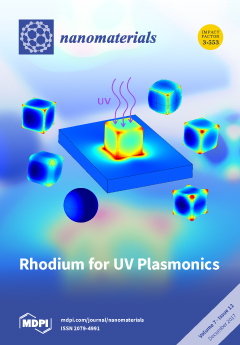We unprecedentedly report that layered MnO
2 nanosheets were in situ formed onto the surface of covalently bonded graphitic carbon nitride/reduced graphene oxide nanocomposite (g-C
3N
4/rGO), forming sheet-on-sheet structured two dimension (2D) graphitic carbon nitride/reduced graphene oxide/layered MnO
2 ternary
[...] Read more.
We unprecedentedly report that layered MnO
2 nanosheets were in situ formed onto the surface of covalently bonded graphitic carbon nitride/reduced graphene oxide nanocomposite (g-C
3N
4/rGO), forming sheet-on-sheet structured two dimension (2D) graphitic carbon nitride/reduced graphene oxide/layered MnO
2 ternary nanocomposite (g-C
3N
4/rGO/MnO
2) with outstanding catalytic properties on thermal decomposition of ammonium perchlorate (AP). The covalently bonded g-C
3N
4/rGO was firstly prepared by the calcination of graphene oxide-guanidine hydrochloride precursor (GO-GndCl), following by its dispersion into the KMnO
4 aqueous solution to construct the g-C
3N
4/rGO/MnO
2 ternary nanocomposite. FT-IR, XRD, Raman as well as the XPS results clearly demonstrated the chemical interaction between g-C
3N
4, rGO and MnO
2. TEM and element mapping indicated that layered g-C
3N
4/rGO was covered with thin MnO
2 nanosheets. Furthermore, the obtained g-C
3N
4/rGO/MnO
2 nanocomposite exhibited promising catalytic capacity on thermal decomposition of AP. Upon addition of 2 wt % g-C
3N
4/rGO/MnO
2 ternary nanocomposite as catalyst, the thermal decomposition temperature of AP was largely decreased up by 142.5 °C, which was higher than that of pure g-C
3N
4, g-C
3N
4/rGO and MnO
2, respectively, demonstrating the synergistic catalysis of the as-prepared nanocomposite.
Full article






